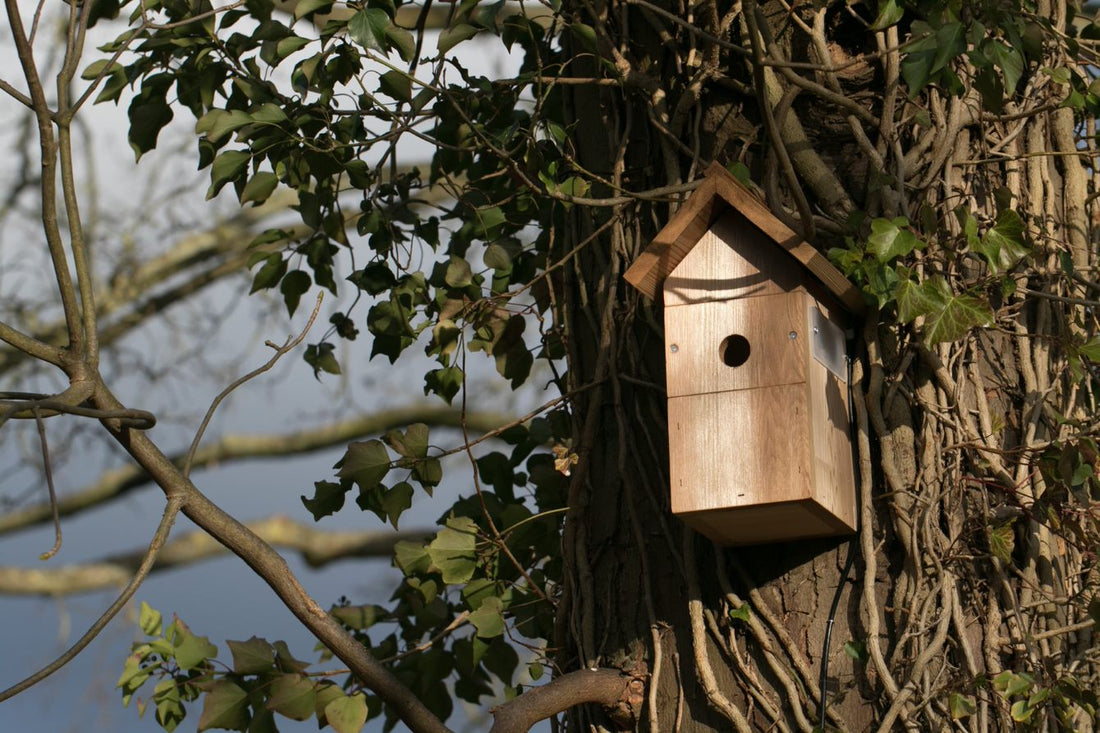Unless there are trees or buildings to provide shade during the day, try to face your bird box between north and east to avoid direct sunlight and the wettest winds. This position should also provide optimum light for your bird box camera. The ideal height for a bird box depends on the species the box is intended for:
- Bird boxes for tits, sparrows or starlings should be securely fixed 2-4 metres off the ground on a tree or a wall.
- Open-fronted bird boxes for robins and wrens should be lower - ideally 2 metres or less from the ground and well hidden in vegetation.
- Spotted flycatchers need a bird box to be 2-4 metres high, and preferably sheltered by foliage but with a clear entry point.
- Woodpecker boxes should be located 3-5 metres high on a tree trunk with a clear flight path and away from anything that may cause a disturbance.
- House sparrows and starlings will happily nest in boxes placed high off the ground under the eaves of buildings. Since they nest in loose colonies, several bird boxes can be spaced out on the same side of a building. However, try to avoid areas where house martins have been known to nest.
Several bird boxes placed close together may be occupied by the same species if they are located on the edge of adjoining territories and there is an abundance of natural food nearby, although this happens more often in the countryside than in gardens, where you would normally only expect one nesting pair of any one species.
The exceptions to this are house martins, tree sparrows and house sparrows, which are all colonial nesting birds. When you put up more than one bird box, you can usually expect to attract several species.
How Do I Attach My Bird Box?
When securing a bird box, try to tilt it forward slightly so that any driving rain will hit the roof and bounce clear, instead of penetrating the entrance hole.
When attaching a bird box to a tree, avoid using nails as they may damage it; nylon bolts or using a strip of wire around the trunk or branch are good alternatives. Consider using a piece of hose or section of car tyre around the wire to prevent any damage to the tree. Remember trees grow in girth as well as height so check the fixing regularly.
When is The Best Time of Year to Put up a Bird Box Camera?
While tits will not prospect for nesting sites until February or March, most birds will begin to investigate nesting sites during the autumn and winter, usually looking for a suitable location to feed and roost. They then often use the same place for nesting the following spring.
How Do I Clean My Bird Box?
Most birds’ nests are known to harbour fleas and various other parasites, which often infest newly hatched or young birds the following year.
Old disused nests should be removed from bird boxes from August onwards, but only once you are confident birds have stopped using the box. Remove your bird box camera from the bird box before removing any nesting materials. Then clean the bird box out with boiling water to kill any remaining parasites. Ensure the bird box is thoroughly dry before reinstalling the bird box camera or replacing the front or lid. Never use insecticides or flea powders in a bird box.
Explore our wide range of bird boxes cameras, wildlife habitats and garden bird boxes by clicking here. And be sure to remember our handy tips when choosing, siting and maintaining your own Gardenature products!




